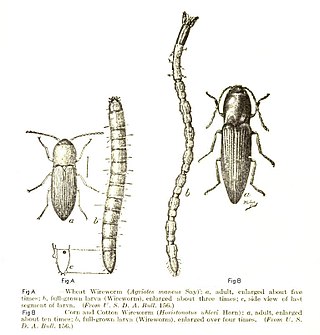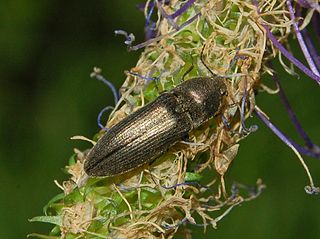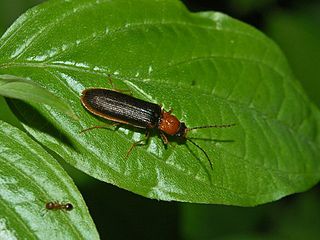
Elateridae or click beetles are a family of beetles. Other names include elaters, snapping beetles, spring beetles or skipjacks. This family was defined by William Elford Leach (1790–1836) in 1815. They are a cosmopolitan beetle family characterized by the unusual click mechanism they possess. There are a few other families of Elateroidea in which a few members have the same mechanism, but most elaterid subfamilies can click. A spine on the prosternum can be snapped into a corresponding notch on the mesosternum, producing a violent "click" that can bounce the beetle into the air. Clicking is mainly used to avoid predation, although it is also useful when the beetle is on its back and needs to right itself. There are about 9300 known species worldwide, and 965 valid species in North America.

Athous haemorrhoidalis is a species of European and Asian click beetles in the genus Athous. Several variations are recognized.

Megapenthes lugens is a species of primarily European click beetle. The adult is black, narrow and 7–10 mm (0.28–0.39 in) long. The larvae feed on weevil larvae in the decaying trunks of beech and elm. In July 2010, the common name "queen's executioner beetle" was proposed following a competition.

Alaus oculatus, commonly called the eastern eyed click beetle or eyed elater, is a species of click beetle.

Cidnopus pilosus is a species of click beetle belonging to the subfamily Dendrometrinae of the family Elateridae.

Denticollis linearis is a species of click beetle belonging to the family Elateridae subfamily Dendrometrinae.

Hemicrepidius hirtus is a species of click beetle belonging to the family Elateridae.

Lanelater fuscipes is a species of click beetle belonging to the family Elateridae subfamily Agrypninae.

Athous vittatus is a species of beetle in the family Elateridae and the genus Athous.

Agriotes lineatus is a species of beetle in the genus of Agriotes from the family of Elateridae. It is commonly known as the lined click beetle.
Athous axillaris is a species of click beetle from the family Elateridae. It was described by George Henry Horn in 1871 and is endemic to California.
Athous curtus is a species of click beetle of the family Elateridae endemic to the Western Caucasus.

Elater ferrugineus, the rusty click beetle, is a species of click beetle belonging to the family Elateridae.

Prosternon tessellatum, the chequered click beetle, is a species of click beetle belonging to the family Elateridae.

Melanotus castanipes is a species of click beetle in the family Elateridae.
Melasis fermini is a rare species of soldier beetles native to a small area of Spain. It has only been found in three locations in Guadalajara, Caceres, and Ciudad Real, and its estimated range is less than twelve square kilometers. The species was named in honor of the late Fermín Martín Piera, a Spanish biologist and taxonomist who specialized in the study of dung beetles.

Ctenicera virens is a species of click beetles.
Elius dilatatus, is a species of click beetle found in India, Sri Lanka, Malaysia and Singapore.
Selasia apicalis, is a species of false firefly beetle found in Sri Lanka.

Athous emaciatus is a species of click beetle in the genus Athous.















